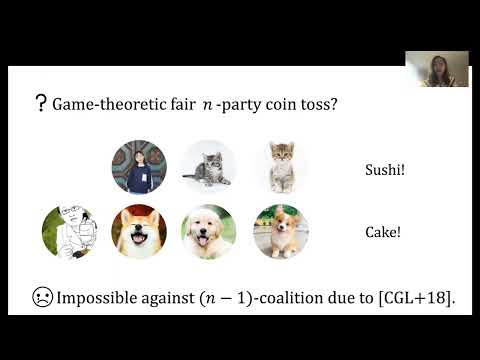CryptoDB
A Complete Characterization of Game-Theoretically Fair, Multi-Party Coin Toss
| Authors: |
|
|---|---|
| Download: | |
| Presentation: | Slides |
| Conference: | EUROCRYPT 2022 |
| Abstract: | Cleve's celebrated lower bound (STOC'86) showed that a de facto strong fairness notion is impossible in 2-party coin toss, i.e., the corrupt party always has a strategy of biasing the honest party's outcome by a noticeable amount. Nonetheless, Blum's famous coin-tossing protocol (CRYPTO'81) achieves a strictly weaker "game-theoretic'' notion of fairness — specifically, it is a 2-party coin toss protocol in which neither party can bias the outcome towards its own preference; and thus the honest protocol forms a Nash equilibrium in which neither party would want to deviate. Surprisingly, an n-party analog of Blum's famous coin toss protocol was not studied till recently. The work by Chung et al.~(TCC'18) was the first to explore the feasibility of game-theoretically fair n-party coin toss in the presence of corrupt majority. We may assume that each party has a publicly stated preference for either the bit 0 or 0, and if the outcome agrees with the party's preference, it obtains utility 1; else it obtains nothing. A natural game-theoretic formulation is to require that the honest protocol form a coalition-resistant Nash equilibrium, i.e., no coalition should have incentive to deviate from the honest behavior. Chung et al. phrased this game-theoretic notion as “cooperative-strategy-proofness'' or ”CSP-fairness'' for short. Unfortunately, Chung et al.~showed that under (n-1)-sized coalitions, it is impossible to design such a CSP-fair coin toss protocol, unless all parties except one prefer the same bit. In this paper, we show that the impossibility of Chung et al.~is in fact not as broad as it may seem. When coalitions are majority but not $n-1$ in size, we can indeed get feasibility results in some meaningful parameter regimes. We give a complete characterization of the regime in which CSP-fair coin toss is possible, by providing a matching upper- and lower-bound. Our complete characterization theorem also shows that the mathematical structure of game-theoretic fairness is starkly different from the de facto strong fairness notion in the multi-party computation literature. |
Video from EUROCRYPT 2022
BibTeX
@inproceedings{eurocrypt-2022-31870,
title={A Complete Characterization of Game-Theoretically Fair, Multi-Party Coin Toss},
publisher={Springer-Verlag},
author={Gilad Asharov and Elaine Shi and Ke Wu},
year=2022
}

